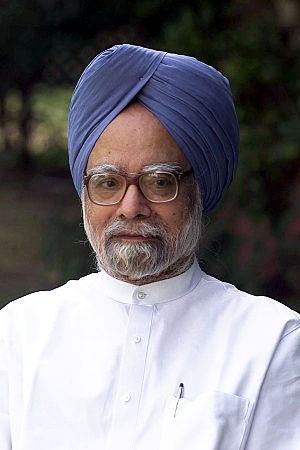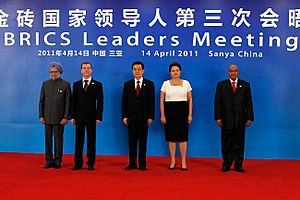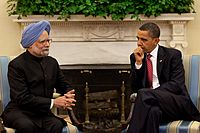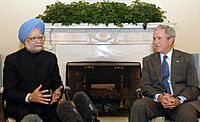Manmohan Singh facts for kids
Quick facts for kids
Manmohan Singh
|
|||||||||||||
|---|---|---|---|---|---|---|---|---|---|---|---|---|---|

Official portrait, 2004
|
|||||||||||||
| 13th Prime Minister of India | |||||||||||||
| In office 22 May 2004 – 26 May 2014 |
|||||||||||||
| President | |||||||||||||
| Vice President | |||||||||||||
| Preceded by | Atal Bihari Vajpayee | ||||||||||||
| Succeeded by | Narendra Modi | ||||||||||||
|
|||||||||||||
| 10th Leader of the Opposition in Rajya Sabha | |||||||||||||
| In office 21 March 1998 – 21 May 2004 |
|||||||||||||
| Prime Minister | Atal Bihari Vajpayee | ||||||||||||
| Chairman | |||||||||||||
| Preceded by | Sikander Bakht | ||||||||||||
| Succeeded by | Jaswant Singh | ||||||||||||
| 22nd Union Minister of Finance | |||||||||||||
| In office 21 June 1991 – 16 May 1996 |
|||||||||||||
| Prime Minister | P. V. Narasimha Rao | ||||||||||||
| Preceded by | Yashwant Sinha | ||||||||||||
| Succeeded by | Jaswant Singh | ||||||||||||
| Member of Parliament, Rajya Sabha | |||||||||||||
| In office 19 August 2019 – 3 April 2024 |
|||||||||||||
| Preceded by | Madan Lal Saini | ||||||||||||
| Succeeded by | Sonia Gandhi | ||||||||||||
| Constituency | Rajasthan | ||||||||||||
| In office 1 October 1991 – 14 June 2019 |
|||||||||||||
| Preceded by | Amritlal Basumatary | ||||||||||||
| Succeeded by | Kamakhya Prasad Tasa | ||||||||||||
| Constituency | Assam | ||||||||||||
| 15th Governor of the Reserve Bank of India | |||||||||||||
| In office 16 September 1982 – 14 January 1985 |
|||||||||||||
| Preceded by | I. G. Patel | ||||||||||||
| Succeeded by | Amitav Ghosh | ||||||||||||
| Personal details | |||||||||||||
| Born | 26 September 1932
|
||||||||||||
| Died | 26 December 2024 (aged 92) New Delhi, India |
||||||||||||
| Political party | Indian National Congress | ||||||||||||
| Spouse | |||||||||||||
| Children | 3, including Upinder and Daman | ||||||||||||
| Alma mater |
|
||||||||||||
| Profession |
|
||||||||||||
| Awards | Full list | ||||||||||||
| Signature |  |
||||||||||||
Manmohan Singh (born 26 September 1932 – died 26 December 2024) was an important Indian leader. He was an economist and a politician. He served as the 13th prime minister of India from 2004 to 2014. He was one of India's longest-serving prime ministers.
Manmohan Singh was a member of the Indian National Congress party. He was the first Sikh person to become prime minister of India. He was also the first prime minister since Jawaharlal Nehru to be re-elected after serving a full five-year term.
He was born in a village called Gah in what is now Pakistan. His family moved to India during the Partition of India in 1947. After studying economics at Oxford University, he worked for the United Nations. He then started his career in the Indian government.
In 1991, India faced a big economic problem. The prime minister at the time, P. V. Narasimha Rao, asked Manmohan Singh to become the finance minister. Singh made big changes to India's economy. These changes helped India's economy grow much faster.
In 2004, the Congress party won the election. Sonia Gandhi, the party leader, chose Manmohan Singh to be the prime minister. During his time as prime minister, India's economy grew quickly. His government also started many important programs for health, education, and jobs.
Contents
Early Life and Learning
Manmohan Singh was born on 26 September 1932. His parents were Gurmukh Singh Kohli and Amrit Kaur. He was born in Gah, which was then part of British India. His family were Punjabi Sikh traders. His mother passed away when he was very young. His grandmother, Jamna Devi, raised him.
He first learned at a local gurdwara, where he studied Urdu and Punjabi. When he was 10, his family moved to Peshawar. He continued his studies there. In 1947, during the Partition of India, his family moved to Haldwani, India. His grandfather was killed during this time, which deeply affected Singh.
In 1948, his family moved to Amritsar. He studied at Hindu College there. He then went to Panjab University. He earned his bachelor's and master's degrees in economics in 1952 and 1954. He was always a top student. Later, he studied at University of Cambridge and University of Oxford. He earned his doctorate (DPhil) from Oxford in 1962. His research was about India's export performance.
Starting His Career
After finishing his studies, Manmohan Singh returned to India. He taught economics at Panjab University. From 1966 to 1969, he worked for the United Nations Conference on Trade and Development (UNCTAD).
He then joined the Indian government. He became an advisor in the Ministry of Foreign Trade. From 1969 to 1971, he was a professor at the Delhi School of Economics.
In 1972, he became the Chief Economic Advisor in the Finance Ministry. He held several important roles in the government. These included:
- Secretary in the Finance Ministry (1976)
- Governor of the Reserve Bank of India (1982–1985)
- Deputy Chairman of the Planning Commission (India) (1985–1987)
He also worked as the secretary general of the South Commission in Geneva, Switzerland. This was an economic policy group. In 1991, he became chairman of the University Grants Commission.
Political Journey
In June 1991, P. V. Narasimha Rao became India's prime minister. He asked Manmohan Singh to be his finance minister. Singh was surprised because he was not a typical politician.
Finance Minister (1991–1996)
In 1991, India was facing a very serious economic problem. The country did not have enough foreign money. Manmohan Singh explained to the prime minister that India needed big changes.
Singh made major reforms to India's economy. He removed many old rules that made it hard for businesses to grow. This system was called the "License Raj." He also reduced taxes on imports. These changes helped open up India's economy. They allowed more foreign investment and helped private businesses. These reforms helped India avoid a crisis and boosted its economy.
Leader in Parliament (1998–2004)
Manmohan Singh was elected to the Rajya Sabha (the upper house of India's Parliament) in 1991. He was re-elected several times. From 1998 to 2004, he was the Leader of the Opposition in the Rajya Sabha. This meant he led the main opposing party in that house of Parliament.
Prime Minister (2004–2014)
Becoming Prime Minister

After the 2004 elections, the Indian National Congress party won the most seats. They formed a group called the United Progressive Alliance (UPA). The leader of the Congress party, Sonia Gandhi, chose Manmohan Singh to be the prime minister. This was a surprise to many. People saw him as an honest leader. He became Prime Minister of India on 22 May 2004.
Economic Growth
As Finance Minister in 1991, Singh had removed the "License Raj." This system had slowed down India's economy for many years. As prime minister, he continued to support economic growth.
Under his leadership, India's economy grew very fast, often at 8–9% each year. In 2007, India had its highest GDP growth rate of 9%. It became one of the fastest-growing major economies in the world. His government also started the National Employment Guarantee Act in 2005. This program helped provide jobs in rural areas.
His government also worked on improving banks and public companies. They helped farmers with their debts. In 2005, a new tax system called the value added tax was introduced.
Health and Education
In 2005, Prime Minister Singh's government launched the National Rural Health Mission (NHRM). This program helped bring health workers to rural areas.
In 2009, his government introduced the Right to Education Act. This law made education free and required for children aged 6 to 14. India became one of the few countries to make education a basic right for every child. His government also opened new IITs (top engineering schools) in several states. They continued the Sarva Shiksha Abhiyan program, which aimed to fight illiteracy by opening more schools, especially in villages.
Keeping India Safe
Singh's government made anti-terror laws stronger. They created the National Investigation Agency (NIA) after the 2008 Mumbai attacks. This agency helps fight terrorism across India.
The Unique Identification Authority of India was also set up in 2009. This agency helps create unique identity cards for people. This helps with national security and government services.

His government also worked to rebuild Kashmir. They also successfully reduced terrorism in Northeast India. In 2005, he apologized for the violence during the 1984 anti-Sikh riots.
Important Laws
During his time, the Parliament passed several important laws:
- The National Rural Employment Guarantee Act (NREGA) in 2005, which provides jobs.
- The Right to Information Act in 2005, which helps people get information from the government. This law has been very important in fighting corruption.
- The Right to Fair Compensation and Transparency in Land Acquisition, Rehabilitation and Resettlement Act, 2013 in 2013, which changed how land is acquired for projects.
- The Right of Children to Free and Compulsory Education Act in 2009, making education a fundamental right.
Working with Other Countries
Manmohan Singh continued India's policy of working well with other countries. He worked to improve peace with Pakistan. He also worked to solve border issues with People's Republic of China. In 2006, the Nathula Pass was reopened after being closed for over 40 years. This helped trade between India and China.
India's relationship with Afghanistan also got much better. India became a big helper for Afghanistan's development.
Singh's government also worked to build stronger ties with the United States. In 2005, he started talks for a special civil nuclear agreement. This agreement allowed India to get nuclear fuel and technology from the US. India also improved relations with Japan and countries in the European Union.

In 2009, Singh was one of the leaders who started the group called BRICS. This group includes Brazil, Russia, India, China, and South Africa. It shows the growing economic power of these countries.
Re-election in 2009

In the 2009 general election, the UPA won again. Manmohan Singh became the prime minister for a second term. He was the first prime minister since Jawaharlal Nehru in 1962 to win re-election after serving a full five-year term. He was sworn in on 22 May 2009.
After Being Prime Minister (2014–2024)
Manmohan Singh's time as prime minister ended on 17 May 2014. He did not run for prime minister in the 2014 election. He resigned after the Bharatiya Janata Party won the election. Narendra Modi became the new prime minister. Singh attended Modi's swearing-in ceremony.
In 2019, he was elected as a member of the Rajya Sabha for Rajasthan. He retired from the Rajya Sabha in April 2024.
Personal Life
Manmohan Singh married Gursharan Kaur in 1958. They had three daughters: Upinder Singh, Daman Singh, and Amrit Singh. Upinder Singh is a history professor. Daman Singh is an author. Amrit Singh is a lawyer.
Manmohan Singh was a vegetarian. He lived in New Delhi until his death.
Later Years and Passing
Manmohan Singh had several heart surgeries. In his later years, he faced some health issues. He was hospitalized a few times for various reasons.
He passed away on 26 December 2024, at the age of 92, in New Delhi. The government announced a period of national mourning. They also said he would receive a state funeral.
Images for kids
-
President A. P. J. Abdul Kalam asking Manmohan Singh to form the government in 2004
-
Singh with Afghan President Hamid Karzai in August 2008
-
Singh with then-American president George W. Bush in Washington DC, September 2008
-
Singh with Egyptian President Hosni Mubarak at the 15th NAM Summit, July 2009
-
Prime Minister Manmohan Singh with Dmitry Medvedev, Hu Jintao, Dilma Rousseff and Jacob Zuma at the 2011 BRICS summit
-
Singh with Japanese Prime Minister Shinzo Abe in May 2013
See also
 In Spanish: Manmohan Singh para niños
In Spanish: Manmohan Singh para niños
- Dr Manmohan Singh Scholarship at the University of Cambridge
- Economic reforms under Manmohan Singh
- First Manmohan Singh ministry
- United Progressive Alliance












